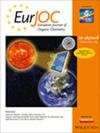Chemo‐Enzymatic Synthesis of Mixed Docosahexaenoic Acid Phosphatidylcholine Conjugates
IF 2.5
3区 化学
Q2 CHEMISTRY, ORGANIC
引用次数: 0
Abstract
Docosahexaenoic acid (DHA, C22:6 n‐3) is a critical omega‐3 polyunsaturated fatty acid (PUFA) with essential roles in brain and retinal functions. Its selective uptake into these tissues is mediated by several pathways, including the transporter Mfsd2a, which preferentially utilizes lysophosphatidylcholine‐DHA (LPC‐DHA) as a substrate. Due to the low de novo synthesis of DHA, optimizing its dietary intake and exploring novel delivery strategies are important in pathologies that affect PUFA proportion. The present work focuses on developing an efficient chemo‐enzymatic methodology to access structured mixed DHA phosphatidylcholines (mixed DHA‐PCs), valuable biological tools for enhancing drug and/or DHA delivery to the brain and retina. Chemo‐enzymatic methods were established to synthesize mixed sn1‐ or sn2‐DHA‐PC isomers, to study the importance of DHA position, from cost‐effective glycerophosphorylcholine (GPC). The approach aligns with green chemistry principles by leveraging lipase‐catalyzed regioselective acylation and deacylation reactions, thus reducing the number of chemical steps compared to traditional methods. The resulting mixed PCs AceDoPC®, DoAcePC (stabilized forms of LPC‐DHA), and phenolic‐DHA‐PCs were produced at a scale suitable for future in vivo studies, enabling investigations into the positional effect of DHA on brain and retinal uptake.求助全文
约1分钟内获得全文
求助全文
来源期刊
CiteScore
5.40
自引率
3.60%
发文量
752
审稿时长
1 months
期刊介绍:
The European Journal of Organic Chemistry (2019 ISI Impact Factor 2.889) publishes Full Papers, Communications, and Minireviews from the entire spectrum of synthetic organic, bioorganic and physical-organic chemistry. It is published on behalf of Chemistry Europe, an association of 16 European chemical societies.
The following journals have been merged to form two leading journals, the European Journal of Organic Chemistry and the European Journal of Inorganic Chemistry:
Liebigs Annalen
Bulletin des Sociétés Chimiques Belges
Bulletin de la Société Chimique de France
Gazzetta Chimica Italiana
Recueil des Travaux Chimiques des Pays-Bas
Anales de Química
Chimika Chronika
Revista Portuguesa de Química
ACH—Models in Chemistry
Polish Journal of Chemistry.

 求助内容:
求助内容: 应助结果提醒方式:
应助结果提醒方式:


